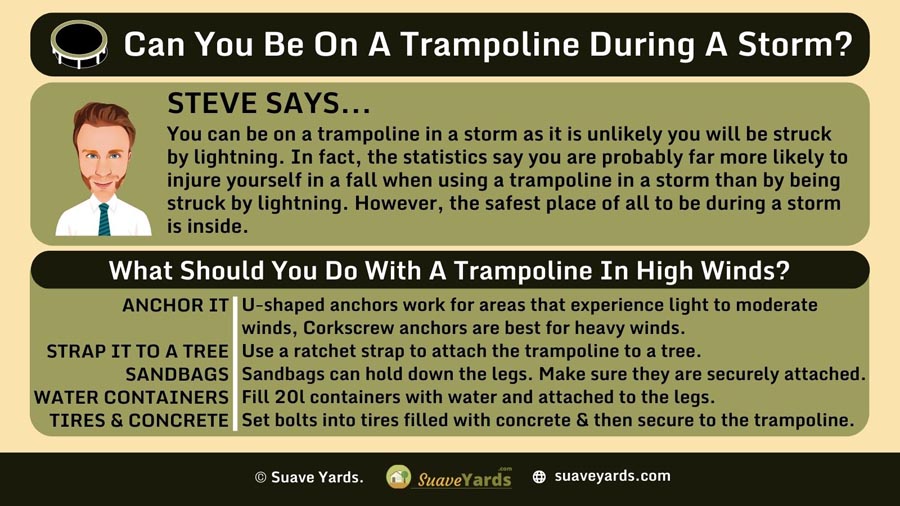
When I was a kid I used to love running around outside in a storm, within reason.
But obviously if things began to get too dangerous my parents quickly ushered me in.
If you live in an area that is prone to high winds and you have a trampoline then no doubt you will have a few questions.
Can you be on a trampoline during a storm? How much wind can a trampoline withstand? And what is the best thing to do with a trampoline when high winds are forecast?
We are going to examine all of that and more in our blog today…
Can You Be On A Trampoline During A Storm?
You can be on a trampoline in a storm as it is unlikely you will be struck by lightning. In fact, the statistics say you are probably far more likely to injure yourself in a fall when using a trampoline in a storm than by being struck by lightning. However, the safest place of all to be during a storm is inside.
Can You Be On A Trampoline During A Storm?
First things first, if a serious storm is coming in, then the safest place to be is always indoors away from the thunder, lightning and potential high winds.
But if, for whatever reason, you are outside on a trampoline, it probably isn’t particularly dangerous because:
- You will be jumping up and down most of the time. Lightning likes to find the most direct route to the ground, and when you are in the middle of the air that is not it.
- Most of your contact on a trampoline will be with the mat. Trampoline mats are made out of polypropylene, which is not a good conductor of lightning so again you are good here.
In short most of what you touch will be non-conductive and you will be in the air so, in theory, you should be safe.
But…
The trampoline is likely to be in an exposed area and is surrounded by a tall steel safety frame that is should be secured to the ground by metal stakes.
So whilst it is unlikely the lightning will strike you, you have to be aware it could strike the frame which poses a risk to you if you are close to it or holding it at the time.
Also we probably need to frame this somewhat.
According to the Centers for Disease Control and Prevention there are over 40 million lightning strikes in the USA each year, and the odds of being struck by lightning are less than one in a million.
And even then 90% of all victims survive.
In contrast, the American Academy of Pediatrics says trampolines cause around 100,000 injuries per year.
So statistically speaking the real risk of being on a trampoline during a storm is not likely to come from lightning, but from you injuring yourself in some other way!
How Much Wind Can A Trampoline Withstand?

Because of their design, trampolines are not very wind resistant.
In fact even Dr Keith Alexander, a professor of mechanical engineering who is on the standards committee for trampoline safety, acknowledges this.
“From a purely aerodynamics point of view, these things (trampolines) are a wing,” he says.
He goes on to say that as soon as there is enough wind to tilt the trampoline even just a fraction, it could soon be on its way out of your backyard.
Part of the reason is that when this happens the safety net that surrounds most trampolines can act like a sail and provide extra momentum to shift your trampoline.
Whilst there are a number of factors that affect how much wind a trampoline can withstand, you will find the figure generally quoted as being the point at which a trampoline can be shifted substantially, if not anchored properly, is around the 40mph mark.
This will be affected by the layout of your yard, where the trampoline is positioned, how well it is anchored and the trampoline itself.
If your trampoline is near a natural wind break such as a wall or fence, then it could take a bit more to shift it.
If it is securely anchored down, it will take a lot more to shift it.
If you have a large Olympic-sized trampoline, it will take more to move it than a tiny one-person child’s trampoline.
But as a general figure, if wind above 40mph is forecast you will want to begin to consider how well-secured your trampoline is.
What Should You Do With A Trampoline In High Winds?
If you are expecting strong winds, then you basically are left with two options for your trampoline:
- Disassemble it completely and store it away.
- Make sure it is securely anchored down.
If you live somewhere that gets a lot of storms and hurricanes, then option 1 will be a pain.
Taking a trampoline to pieces can be time-consuming, and you might not want to do that multiple times over a few months.
Therefore making sure it is properly anchored down is essential and there are a few options.
OPTION 1: Use Trampoline Anchors
Some trampolines come with a set of anchors to secure them into the ground.
If yours doesn’t then it is always a good idea to buy some.
There are generally two types of trampoline anchors:
- U-Shaped Anchors: For light to mid-wind areas.
- Corkscrew Anchors: For high wind areas.
Both types of anchor will provide considerable extra protection for your trampoline, but as corkscrew anchors literally screw into the ground they are less likely to be pulled out by very high winds.
In fact, when I was quickly browsing Amazon for trampoline anchors I read the reviews of the Eurmax USA trampoline stakes (other makes are available!) and there were a couple of user reviews saying it helped their trampoline stay secured in 100mph plus winds!
Take a look at trampoline anchors on Amazon.
OPTION 2: Strap It To A Tree
This is actually the option that the aforementioned expert Dr. Alexander suggests, he said:
“One thing that’s pretty sensible if you could rope it to something. If there’s a tree and you put a rope around it. The wind might blow but it won’t go anywhere.”
Find a sturdy tree and ratchet strap your trampoline to it, and it should be secured even in the strongest winds.
OPTION 3: Use Sandbags
One question people seem to ask quite a lot is whether sandbags will hold down a trampoline.
The answer is yes, unless we are talking about some ridiculously high winds, sandbags are a very effective way of keeping a trampoline secure.
Obviously the more sandbags the better.
Also make sure the legs of the trampoline are securely attached to the frame.
If they aren’t well attached, then the sandbags will hold down the legs, but the trampoline mat itself might be detached from them and attempt to leave your yard separately.
OPTION 4: Use Water Containers
A similar option to using sandbags is to buy large water containers (20l or more should do the trick), fill them with water and tie them to the frame of the trampoline.
That should stop the trampoline from shifting in most conditions.
OPTION 5: Use Tires Filled With Concrete
Another good option I read about when researching this issue was to fill old tires with concrete, then set bolts into the concrete, and use rope/a ratchet strap to attach the trampoline to the bolts.
Make sure you have the tires in the right place before you start adding the concrete though!
OPTION 6: Remove the Net
This option really runs in conjunction with any of the suggested ideas above.
As mentioned near the start, the safety net can act as a sail in high winds for a trampoline giving it much more momentum in high winds.
If you can easily remove the net I would always suggest you do that along with making sure your trampoline is secured properly.
Make sure you put the net back on when you come to use the trampoline again, using a trampoline without a net isn’t a good idea!
Final Thoughts

We have answered a few FAQs here, but to summarize.
Yes you can be on a trampoline during a storm, as it is unlikely you will be struck by lightning, but the safest place is always to be inside!
Generally it is acknowledged most trampolines, that aren’t properly secured, can withstand gusts of wind up to 40mph.
Finally there are a number of things you can do to keep your trampoline from blowing away in high winds.
If you cannot disassemble it completely then you want to make sure it is properly secured.
You can do this with specialist trampoline anchors, but you can also ratchet strap it to a tree or use anything big and heavy such as sandbags, containers filled with water or even tires with concrete in them.
Good luck!
